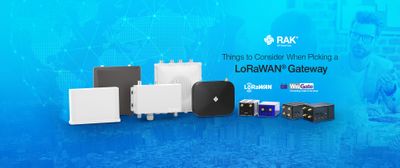RAK CEO, Ken Yu, Presents the Best Practices to Select the Right Gateway at TTN Conference India 2019
RAKwireless provides comprehensive products and services for LoRa-based edge devices, gateways, and IoT infrastructure. Our HQ is based in Shenzhen, China, “Asia’s Silicon Valley”, which has one of the world’s largest ecosystems of technology companies, and that directly benefits us.
Our founding team has worked in the wireless communications industry for over ten years. Five years ago, we started this company together because we believed that one day, everything will be connected. Our ambition was to create a world that is safer, smarter, and more productive through IoT. However, IoT is vast and complex, so we aim to make it streamlined and simple. Through this simplicity, we create clarity, which ultimately leads to effective outcomes for our customers.
We are a Chinese company with a globalized mindset.
RAK is fundamentally different from the average IoT supplier in China as we operate on a decentralized model, with teams based in China, South East Asia, India, and Eastern Europe. Our global teams allow us to support customers in key markets more directly. We are eager to engage and support our customers - a strategy that has differentiated us and successfully driven our growth, which in turn has grown the IoT and LoRa community.
Choosing the right LoRaWAN Gateway
“How do you choose the right LoRaWAN gateway?” This question is frequently asked. While there are many IoT applications, there are common key factors to consider:
- What is the purpose of the gateway? Are you going to use it for application development, or will it be part of a commercial operation?
- Do you want to manage your own private network server for privacy and security benefits, or are you willing to use a publicly available service like The Things Network to reduce development time?
Gateway Purpose: Development or Commercial?
If you are doing application development then a simple LoRaWAN module add-on for the common Raspberry Pi, or similar ‘maker’ SBC platform, is perfectly suitable. This option is very cost-efficient, giving a great platform to develop, test and simulate an application in a lab.
In this regard, RAK offers 8-channel concentrator modules for development purposes, including the RAK831, RAK833 and RAK2245. These modules are ideally suited to the Raspberry Pi, but compatible with Laptops using FTDI to run the gateway program.
When planning for commercial deployment, your gateway selection should highlight its long-term capability as a permanent installation. Gateways such as this need to work reliably even in harsh environments.
In other words, your gateway must have excellent quality enclosures with an IP67 to an IP68 rating. Moreover, simplifying power and internet connectivity with PoE Ethernet is preferred because it’s the most reliable and straightforward option, although wireless via Cellular or Wi-Fi can be used instead, or even added as a redundancy connection option.
For commercial applications, RAK offers the cost-effective RAK7249 outdoor gateway with an IP67 enclosure, PoE, Wi-Fi, and LTE connectivity options. It is extremely power-efficient and can even work with a battery, allowing more flexible deployment options.
Working with a Private or Public Network
Whether you are considering private or public services, the gateway should support multiple protocols like HTTP, HTTPS, MQTT bridges, and allow User Authentication.
If you are building a private network for security and privacy advantages, then the gateway should be configurable to partner with a private network server. When using relatively few devices, or in a remote deployment where cellular network reception is extremely poor, then using a gateway with an internal LoRa server is the best option because it reduces the overall deployment cost and provides service reliability even when the external network is unavailable.
RAK’s RAK7249 and RAK7258 WisGate Edge Lite (upgrade RAK7268 WisGate Edge Lite 2) feature a built-in LoRa server that can support up to 125 devices. It also features HTTP, HTTPS, MQTT bridge, and the Legacy Semtech UDP protocol.
Managing and Mitigating Deployment Problems
Sometimes, there are practical problems while deploying gateways.
Unreliable Backhaul (Internet) Connection
An external network connection can fail, so to ensure the LoRaWAN system doesn’t lose any data collection in the interim, the data should be stored on the gateway itself. This requirement allows for an embedded server in the gateway. Using a watchdog function, it can monitor the network connection state and hold the data until the connection resumes, providing a level of system redundancy to ensure no data is lost.
Reducing Cellular Internet Cost
While LoRaWAN uses a freely available unlicensed wireless spectrum, if you’re using a cellular data connection to forward the data from nodes to a server, you can still expect exorbitant costs. Using a gateway with a whitelisting function filters unnecessary data to only forward what is necessary to you. This function can effectively reduce data traffic and operational costs.
Mitigating Packet Loss
The third problem that can require some work is (serious) packet loss, which is often due to interference. Available wireless channels need to be assessed for noise and stability during the deployment process because the connectivity of each node can vary. This requires a gateway with user-friendly UI to streamline the process, saving time and operational costs, especially when there are dozens-to-hundreds of nodes to deploy. Therefore, a friendly WebUI with easily understood statistical tools is essential for rapid diagnostics.
The design and manufacturing quality of each node can also impact the connection quality; using a high-quality antenna and node with inherently good RF design is essential for a reliable connection.
Choosing nodes and gateways from a single supplier also reduces the potential for connectivity problems, as these devices are designed to work together and examined through extensive testing.
Creating your own a LoRaWAN Gateway
It is suggested that you choose an open-source ecosystem for the development of the hardware platform. Using a Raspberry Pi as the base platform allows access to the source code, which can be modified according to your needs. It has ample performance to run customized software and creates options for add-ons and deployment customizations.
At the gateway, OpenWRT Linux provides great flexibility and customization. It is intentionally designed for network routing and is very well supported.
Shall I Use a Simple Packet Forwarder? No!
Many people think they need a simple packet forwarder-based gateway to reduce costs and speed development time. Unfortunately, in most scenarios, this is a false economy. Therefore, more enhanced features still result in a more secure, more reliable network.
Ensure your gateway supports these features:
- Secure connectivity with SSL/TLS
- Additional protocol support apart from traditional Semtech UDP
- MQTT over TLS connectivity with authentication support
- VPN connectivity to connect private networks
- DDNS function to enable a fixed IP address, which is very useful for cellular connections where the IP assignment is dynamic.
- In the final product launch, you need to facilitate the process of launching a new gateway through DEVEUI and APPKEY. This type of launch reduces the need to reconfigure each end-device.
Gateway Installations
Another challenging job is the gateway deployment itself. These gateways are always equipped with the necessary accessories for quick and reliable installation, especially when outdoors. In this regard, consider factors that can affect long-term performance, like weather, its weight relative to its mounting, ESD and the possibility of lightning strikes.
Is the gateway installation in reach of an Ethernet cable (i.e. can you use PoE)? Or, does it rely on a wireless connection? If the installation relies on a cellular connection, you need to minimize traffic costs with node whitelisting, metadata optimization, and data failsafe mechanisms in case the network environment becomes unreliable.
Is the power supply stable? If not, it requires a backup battery to support the gateway until the power is restored. However, in remote locations, a power supply may not even be available, or some customers might want to pursue deployments that focus on renewable power sources such as the combination of solar panels and batteries. Even if the gateway is running at full capacity, a RAK gateway’s power consumption should only reach, at most, 10W, enabling this kind of eco-friendly setup.
Conclusion
The installation requirements of a gateway are determined by its applications. By working closely and listening to our customers, we understand the specifics of their requirements. We develop and offer a wide range of features as possible, to comprehensively meet their needs, while keeping things simple and straightforward for our customers.
Read more Decoding LoRa Technology: Understanding the Differences Between LoRaWAN®, LoRa P2P, and LoRa Mesh







